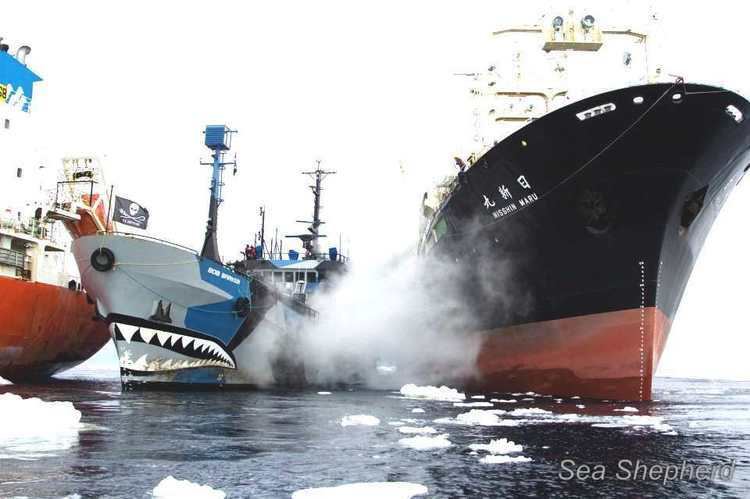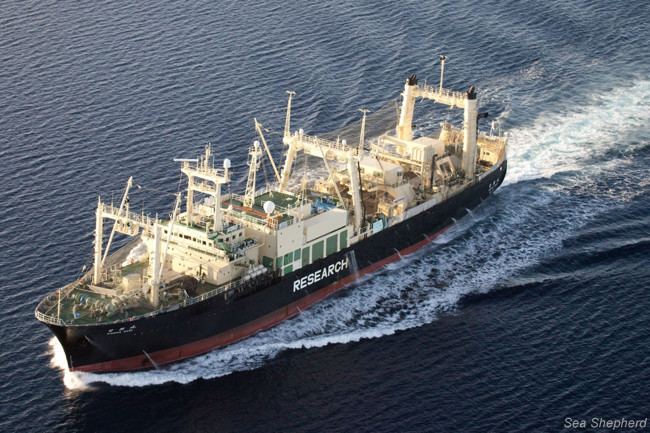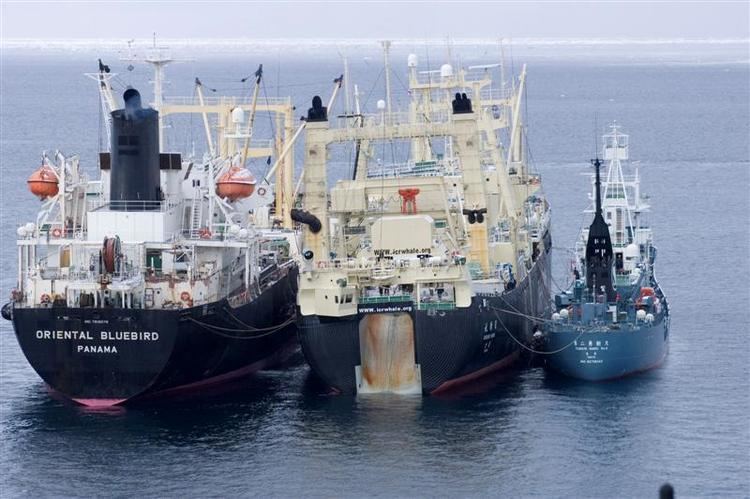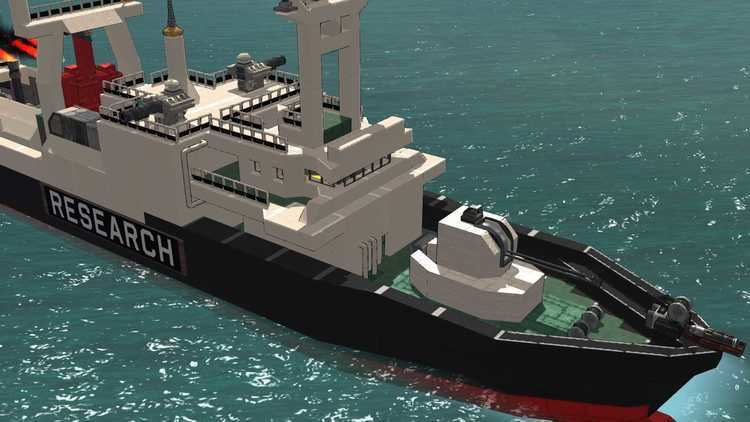Port of registry Japan Construction started 1987 Length 130 m | In service Active Launched 30 August 1987 Beam 19 m | |
Name Nisshin Maru (Previously Chikuzen Maru) Builder Hitachi Zosen Corporation Innoshima Works | ||
Bob barker encounter with yushin maru 2 transfers poached whale to nisshin maru
The 8,145-ton vessel MV Nisshin Maru (日新丸) is the primary vessel of the Japanese whaling fleet and is the world's only whaler factory ship. It is also the largest member, and flagship of the five member whaling fleet, headed by research leader Shigetoshi Nishiwaki, and is based in Japan in Shimonoseki harbor. The ship is owned by Tokyo-based company Kyodo Senpaku Kaisha Ltd.which is a subsidiary of the Institute of Cetacean Research.
Contents
- Bob barker encounter with yushin maru 2 transfers poached whale to nisshin maru
- The nisshin maru rams the sss bob barker sss steve irwin and south korean tanker sun laurel
- History
- 2007 Antarctic voyage
- Other incidents
- IMO regulations
- In popular culture
- References

The nisshin maru rams the sss bob barker sss steve irwin and south korean tanker sun laurel
History

There have been several Japanese factory whaling ships named Nisshin Maru. After the U.S. Navy's Pacific Fleet was attacked at Pearl Harbor in December 7, 1941, all Japanese factory ships soon began to serve in the war effort till sunk or till the end of World War II in 1945.

General Douglas MacArthur, as military governor of Japan in 1945, encouraged the now defeated Japan to continue whaling in order to provide a cheap source of meat to its starving people, and to supply millions of dollars in oil for the United States and Europe. The Japanese whaling industry quickly recovered as MacArthur authorized the commission of two converted T2 tankers as whaling factory ships (Hashidate Maru and Nisshin Maru No. 1), to once again take whales in the Antarctic and elsewhere.

2007 Antarctic voyage
A major fire in the ship's processing factory broke out on February 15, 2007 while in Antarctic waters. The resulting damage caused the ship to be temporarily disabled, all while continuing to carry approximately 1,000 tons of oil. This incident took place within the New Zealand Search and Rescue Region. One crew member was killed in the fire.
Citing environmental concerns, specifically the disabled ship's proximity to Cape Adare, Antarctica and the world's largest Adelie penguin rookery, New Zealand Conservation Minister Chris Carter joined international citizens' groups in urgently requesting that the ship be towed away. Japan's Institute of Cetacean Research (ICR), which administers the ship with the Kyodo Senpaku Kaisha, declined offers of a tow from the Greenpeace ship MV Esperanza, which had been nearby and monitoring the situation since February 17. On February 28, the ICR released a statement on its decision to cut short its Antarctic whale hunt for 2006/07 due to unrecoverable equipment, and the Nisshin Maru departed for Japan.
Other incidents
The Nisshin Maru and Greenpeace's MV Arctic Sunrise collided in December 1999 and in January 2006. In 2006 both ships claimed to have been rammed by the other, and the ICR posted video footage to support its version of the incident. Greenpeace responded that the waves emanating from the Arctic Sunrise in the video support Greenpeace's contention that its vessel had its engines in reverse; Greenpeace also claimed the location of cloud formations in the background of the ICR video indicate the MV Nisshin Maru was turning into the Greenpeace ship at the time of collision.
Sea Shepherd Conservation Society claimed its president Paul Watson was shot by someone on the Nisshin Maru during a confrontation with the MY Steve Irwin off Antarctica in 2008. He was wearing a bulletproof vest and was uninjured. An ICR spokesman acknowledged that seven flashbangs were thrown, but stated that "no gunshots of any kind" were fired.
In March 2011, the Nisshin Maru returned early from operations in the Southern Ocean and immediately began assisting in disaster relief efforts following the 2011 Tōhoku earthquake and tsunami, transporting food, fuel, and other supplies to areas devastated by the catastrophe.
In February 2013, the Nisshin Maru was involved in a multiple-ship collision, colliding with the Sea Shepherd vessels the MY Steve Irwin, the MY Bob Barker, and the MY Sam Simon, as well as the whaler's refueling ship, the Sun Laurel. The Bob Barker was damaged and issued a mayday. The Sun Laurel's lifeboats were also damaged due to the collision.
IMO regulations
Additional regulations from the United Nations International Maritime Organization (IMO) took effect on August 1, 2011 prohibiting ships using heavy oil fuel below 60 degrees south to prevent pollution. The IMO Guidelines For Ships Operating In Ice-Covered Waters also establishes requirements for a double-hull strengthened against ice-related damage. As of 2011 the Nisshin Maru did not meet the IMO standards.
In popular culture
The Nisshin Maru is featured in the video game Ship Simulator Extremes, along with the Kyo Maru # 1 and the Greenpeace vessel Esperanza with its outboard inflatable boats and RIBs. It was the main setting for the movie Drawing Restraint 9.
Nisshin Maru is the name of a whaler factory vessel that is chased by greenpeace and a German/chilean press officer in Luis Sepulveda's book "Mundo del fin del mundo".
